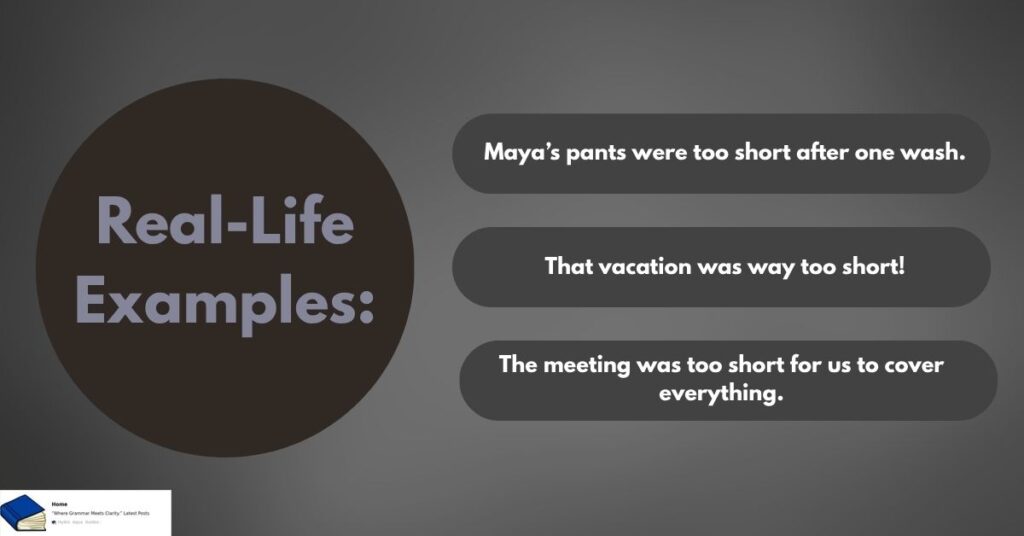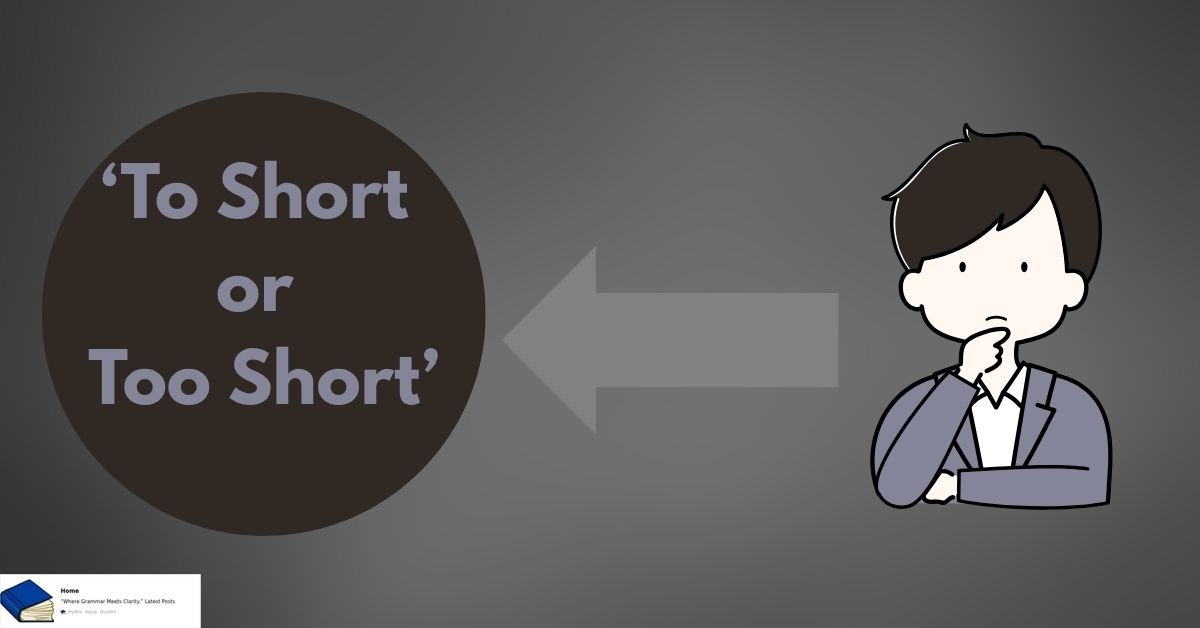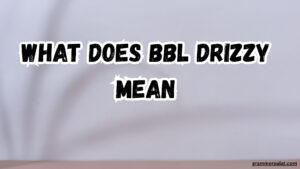Have you ever typed out a sentence like “This shirt is to short” and paused, wondering if something didn’t quite look right? You’re not alone. One of the most common grammar mix-ups in English is choosing between “to” and “too” especially in phrases like “too short” vs “to short.” If you’ve ever asked yourself, “Is it to short or too short?” this article is for you. Let’s unpack this common mistake and help you master it once and for all.
What’s the Confusion?
The main issue here comes down to homophones in English words that sound the same but have different meanings and spellings. In this case:
- To = a preposition or part of an infinitive verb (e.g., to go, to eat).
- Too = an adverb meaning “also” or “excessively.”
So, when someone writes “to short” instead of “too short,” it’s not a minor typo it’s a grammatical error.
Let’s break this down even further.
To vs Too: A Quick Grammar Refresher
Before we dive into examples of “too short or to short”, let’s clarify the difference between to and too.
“To” – The Preposition or Infinitive Marker
- Usage: Shows direction, place, or purpose.
- Examples:
- I’m going to the market.
- He likes to sing.
“Too” – The Adverb
- Usage: Means “also” or “excessively.”
- Examples:
- I want to go too (also).
- The soup is too hot (excessively).
So… Is It “To Short” or “Too Short”?
Let’s answer this right away:
Correct: Too short
Incorrect: To short
When you say something is “too short”, you’re using “too” to describe the degree of shortness. You’re saying something is excessively short, not just short.
- Correct Sentence: The skirt is too short for school.
- Wrong Sentence: The skirt is to short for school.
See the difference?
Why “To Short” Is Always Wrong
“To short” doesn’t work grammatically in standard English. That’s because “to” isn’t an adverb, so it can’t modify adjectives like “short.” There’s simply no valid use case in which “to short” would make sense on its own.
Imagine someone saying:
- “His patience was to short.”
This sentence is grammatically incorrect because “to” doesn’t function as a modifier of the adjective “short.”
Common Reasons People Get It Wrong
Let’s look at why this mistake happens in the first place.
1. They sound the same.
In speech, “to” and “too” are pronounced identically. So it’s easy to mix them up while writing.
2. Autocorrect or typos.
Your phone or keyboard might auto-suggest “to” instead of “too” and let’s be honest, most of us don’t double-check.
3. Unfamiliarity with grammar rules.
Many learners and even native speakers haven’t been clearly taught the proper usage of too vs to.
When to Use “Too Short” (With Examples)
The phrase “too short” is used to describe something that’s not long enough, often to the point of being problematic.

✔ Tips to Remember:
If you can substitute “very short” and the sentence still makes sense, use “too short.”
- The speech was very short → The speech was too short.
- Her patience was very short → Her patience was too short.
When “To Short” Appears And Why It’s Wrong
Some people mistakenly write:
- “My time is to short.”
- “This chair is to short for the table.”
Again, in all these cases, they meant “too short” but accidentally wrote “to short.”
There’s only one rare case where “to short” might appear as part of a verb phrase in technical or mechanical contexts (e.g., “to short-circuit”). But even then, it’s part of a verb, not an adjective phrase.
Example:
- The wire is likely to short if it’s exposed. (This is very uncommon and not related to “too short.”)
Real-World Examples: “Too Short” in Action
Let’s bring in some realistic examples with names to help things stick.
Fashion:
- Jessica told her daughter, “That dress is too short for school.”
Writing:
- Mr. Daniels marked the assignment incomplete. “It’s too short,” he said. “The word count was 500; you wrote 212.”
Sports:
- “You’re too short to play center,” joked James. “But your three-point shots are deadly!”
Table: To vs Too – Quick Comparison
| Word | Function | Meaning | Example |
|---|---|---|---|
| To | Preposition / Infinitive | Direction or purpose | Go to the store / To be clear… |
| Too | Adverb | Also / excessively | I’m going too / It’s too short |
Frequently Asked Questions
Q: Is it “to short” or “too short”?
A: Always “too short.” The word “too” shows an excessive amount.
Q: Why is “to short” wrong?
A: Because “to” is a preposition and can’t modify adjectives like “short.” It doesn’t make sense grammatically.
Q: What’s the rule for too and to?
A: Use “to” for direction or infinitives. Use “too” when you mean “also” or “excessively.”
Q: What does “too short” mean?
A: It means something is shorter than needed or expected.
Tips to Remember the Difference
If you struggle with this, here are a few memory tricks.
Tip 1: Think of “too” as “excessive” – and it has an extra ‘o’ to show extra-ness.
- Too = Exaggeration (Too cold, too late, too small)
Tip 2: Swap it with “very” in your head.
- If “very” fits, you want “too.”
- Too short = Very short
Tip 3: “To” never describes something. It points to something.
SEO-Driven Usage Examples
Here are some optimized examples using relevant key phrases:
- If you’re wondering is it to short or too short, the correct form is always “too short.”
- “To short or too short” might seem confusing, but only one of them is right.
- Understanding the to short or too short grammar rule can help you avoid common mistakes.
- Many people ask, “Too short or to short—which one should I use?” The answer is easy: always use “too short.”
- Remember: To short is incorrect unless it’s part of a rare verb structure like “to short-circuit.”
Common Mistakes with “Too” and “To” (And How to Fix Them)
❌ Mistake: “You’re to late.”
✔ Fix: “You’re too late.”
❌ Mistake: “It’s to hot today.”
✔ Fix: “It’s too hot today.”
❌ Mistake: “That essay is to short.”
✔ Fix: “That essay is too short.”
How to Explain “Too Short” to Students
Teachers, tutors, or ESL instructors can use these strategies:
- Use visuals or emoji (e.g., 📏❌ for “too short”).
- Write examples on a board:
- “The rope is too short.”
- “He went to the store.”
Ask students to explain which “to/too” is correct and why.
- Have learners read sentences out loud, then ask:
“Can you replace ‘too’ with ‘very’? If yes, you’ve got it!”
How to Avoid the “To vs Too” Mix-Up in the Future
Here’s how to stop writing “to short” instead of “too short” forever:
- Proofread: Always re-read for homophone mistakes.
- Slow down: Don’t rely too much on autocorrect.
- Practice: Write out examples of correct vs incorrect usage.
- Teach someone else: Explaining it reinforces your own understanding.
Conclusion
Grammatical errors like “to short or too short” may seem small, but they can leave a big impact especially in formal writing. Thankfully, now you know why “too short” is correct, why “to short” is wrong, and how to remember the rule with ease.
So the next time you’re writing a message, blog post, or even a tweet, pause and check:
Is it “to short” or “too short”?
Now, you know the answer. Always go with “too short.”









